Tamron F012 Handleiding
Bekijk gratis de handleiding van Tamron F012 (3 pagina’s), behorend tot de categorie Lens. Deze gids werd als nuttig beoordeeld door 40 mensen en kreeg gemiddeld 4.9 sterren uit 20.5 reviews. Heb je een vraag over Tamron F012 of wil je andere gebruikers van dit product iets vragen? Stel een vraag
Pagina 1/3

5
5
3
TLM-EDFSIPNCKRIdSv-F012-T/T-1506
SP35mm F/1.8
Di VC USD
(
for Nikon, Canon
)
SP35mm F/1.8
Di USD
(
for Sony
*Models without the VC
)
Model:
F012
* The Marking is a directive conformity mark of the European Community (EC).
* Das -Zeichen entspricht der EC Norm.
* La marquage est un marquage de conformité à la direcive CEE (CE).
* La marca es marca de conformidad segun directiva de la Comunidad Europea (CE).
* Il marchio attesta la conformita alla directtiva della Comunità Europea (CEE).
* 标志表示符合欧州共同体(EC)指标
The EEC Conformity Report applies to the Council
Directive 98/336/EEC, 92/31/EEC, 93/68/EEC and
is used by Tamron Co., Ltd., manufacturer of this
product.
Nikon
Sony
Canon
* F004: This model is Built-in Motor
12
11
10
9
12
11
10
9
10
12
11
2
3
1
6
7
8
5
4

ENGLISH
Thank you for purchasing the Tamron lens as the latest addition to your photographic equipment.
Before using your new lens, please read the contents of this Owner’s Manual thoroughly to
familiarize yourself with your lens and the proper techniques for creating the highest quality
images possible. With proper handling and care, your Tamron lens will give you many years of
photographing beautiful and exciting pictures.
• Explains precautions that help to prevent problems.
• Explains things you should know in addition to basic operations.
NOMENCLATURE (Refer to Fig. , if not specied)
① Lens hood ② Hood attaching alignment mark
③ Hood attaching indicator ④ Filter ring
⑤ Hood attaching bayonet ring ⑥ Focusing ring
⑦ Distance scale ⑧ Distance index
⑨ VC (Vibration Compensation) switch ⑩ AF/MF switch (Figs. & )
⑪ Lens attachment mark ⑫ Lens mount/Lens mount contacts
SPECIFICATIONS
F012
Focal Length 35 mm
Maximum Aperture F/1.8
Angle of View 63˚26'
Optical Construction 9/10
Minimum Object Distance 0.2 m (7.9'')
Maximum Magnication Ratio 1:2.5
Filter Size ø 67 mm
Length/Overall Length 78.3 mm (3.1'')/86.6 mm (3.4'')*
Maximum Diameter ø 80.4 mm (3.2'')
Weight 450 g (15.9 oz)*
Lens Hood HF012
* values are specications of Nikon products. Length: Distance from the lens front extremity to the
mount surface.
Overall length: Distance from the lens front extremity to the rear projection extremity.
Features and appearance of lenses listed in this owner’s manual are subject to change without
notice.
ATTACHING AND REMOVING THE LENS
How to mount the lens
Removing the rear cap of the lens. Align the Lens attachment mark ⑪ on the lens barrel with
its counterpart on the camera mount and insert the lens.
Rotate the lens clockwise until it click-locks. For Nikon models, align the lens attachment mark
with the dot on the camera and rotate the lens counter-clockwise until it click-locks.
How to detach the lens
Pressing the lens release button on the camera down, turn the lens counter-clockwise (in case
of Nikon lens, clockwise), and lift the lens off the camera’s lens mount.
Ensure that the camera is turned off when attaching or removing the lens.
For further details, please read the instruction manual of your camera.
FOCUSING (Autofocus) and using the full-time manual function
In case of a Nikon or Canon camera, switch the AF/MF switch ⑩ on the lens to AF (Fig. ). In
case of a Nikon camera with the focus mode selector dial, set the focus mode to S, C or A, and
then set the AF/MF switch
⑩ on the lens to AF. Press the shutter button halfway down while
viewing through the camera’s viewnder, the lens focuses automatically. An in-focus mark will
light when lens focuses on the main subject sharply. Press the shutter button further to
photograph.
In case of a Sony camera, switch the AF/MF switch
⑩ on the lens to AF (Fig. ), and set the focus
mode on the camera to Auto focus (AF). Press the shutter button halfway down while viewing
through the camera’s viewnder, the lens focuses automatically. An in-focus mark will light when
lens focuses on the main subject sharply. Press the shutter button further to photograph.
Using the full-time manual function
F012 is equipped with the full-time manual function.
The full-time manual function is a function that the focus can be ne-tuned by the manual
focus without switching the AF/MF changing switch when taking a picture of auto focus.
How to use the full-time manual function
First, set the focus mode to “AF”.
You can adjust focus manually while turning the focus ring in the shutter button is pressed
lightly.
The distance scale ⑦ is marked for guidance purposes. The actual focal point may slightly differ
from the distance marked on the focal length index.
For further details, please read the instruction manual of your camera.
FOCUSING (Manual Focus) (Ref. Figs., & )
In case of a Nikon or Canon camera, switch the AF/MF switch ⑩ on the lens to MF (Fig. ). Focus
manually rotating the focusing ring
⑥ while viewing through the camera’s viewnder (Fig. ).
The main subject in the viewnder will be sharp when the lens is focused correctly.
In case of a Sony camera, switch the AF/MF switch
⑩ on the lens to MF (Fig. ), and set the
focus mode on the camera to Manual focus (MF). Focus manually rotating the focusing ring
⑥
while viewing through the camera’s viewnder (Fig.
). The main subject in the viewnder will be
sharp when the lens is focused correctly.
Even in the MF mode, when turning focusing ring ⑥ while pressing the shutter button halfway, the focus
aid function lamp lights up when the picture is in focus.
At innity, make sure the image in the viewnder appears sharp. The innity position is made with certain
allowances to insure proper focus under a variety of conditions.
For further details, please read the instruction manual of your camera.
VC MECHANISM (Ref. Figs. , & ) (Mounted for Nikon and Canon models)
VC (Vibration Compensation) is a mechanism which reduces the image blur caused by hand-held
shooting.
How to use VC mechanism
1) Set the VC switch ⑨ on.
*When VC is not used, set the switch off.
2) Press the shutter button halfway to verify the effect of the VC.
When the shutter button is pressed down halfway, it takes about 1 second for the VC to
provide a stable image.
The VC can be effective for hand-held shots under the following conditions.
Dimly lit locations
Scenes where ash photography is forbidden
Situations where your footing is uncertain
Taking panning shots of a moving subject
The VC may not be able to give full effect in the following cases:
When a photograph is taken from a fast movimg vehicle
Shooting during the excessive movement of the camera
When taking photographs using a tripod
Turn the VC switch OFF when taking pictures with the bulb setting or during long exposures. If
the VC switch is ON, the VC mechanism may introduce errors.
With the VC mechanism, there are occasions that the image in the viewnder blurs right after the
shutter button is pressed down halfway, but this is not a malfunction.
When the VC is ON, the number of images recordable is reduced due to the power used from the
camera.
When the VC is ON, immediately after the shutter button is pushed halfway down and
approximately 2 seconds after a nger releases the shutter button, the camera will “click”. This
sound is the VC's locking mechanism activating, not a malfunction.
Turn the VC switch OFF when using tripod.
When the lens is removed from the camera while VC is activating, the lens may make clicking sound when
the lens is subjected to a jolt. This is not a malfunction.
The VC activates while the “release” button is pushed halfway down. (It is activated 2 seconds after the
shutter button is released)
VC can be used in AF or MF mode.
LENS HOOD (Ref. Figs. , to )
A bayonet-type lens hood (referred to as “hood” below) is provided as standard equipment. We
recommend shooting with the hood attached whenever possible as the lens hood eliminates stray
light, which is harmful to the picture. However, please be aware of the precautions stated in the
next section when your camera is equipped with a built-in ash.
Attaching the Lens Hood (Ref. Figs. & )
Align Hood attaching alignment mark ② on the hood with the corresponding index mark ⑤ or
the top of the index line of the distance scale on the lens. Press the hood lightly onto the hood
attaching bayonet ring (Fig.
) and then rotate it clockwise to secure (Fig. ). The lens hood
will be secure when the mark is at the top (Fig.
). When attaching the lens hood, hold the
focus and zoom control rings so that they are not rotated unintentionally.
Pay particular attention to align the hood attaching indexes when using zoom lenses including
wide-angle (e.i. 35mm or wider) settings.
Improper attachment of a hood on a wide-angle zoom lens may cause large shadowed areas in
your pictures.
Stowing lens hood on the lens (Ref. Fig. )
1) Reverse the lens hood. Point the lens toward the opening, then align the hood attaching
index
⑤ on the lens with the alignment on the hood attaching indicator ③.
2) Turn the hood clockwise until the alignment mark (•) is at the top to set it. (Fig.
)
PRECAUTIONS IN SHOOTING
The optical design for Di takes into consideration the various features of digital single reex
cameras. However, due to the conguration of the digital single reex cameras, even when the
autofocus accuracy is within specications, the focal point may be a little forward or behind the
optimum point when shooting with autofocus under some conditions.
The Tamron lenses described here employ an internal focusing (IF) system. Because of the
characteristics of this optical design, the angles of view at distances other than innity are wider
than that of the lenses applying an ordinary focusing system.
When the built-in ash on the camera is used, adverse photographic phenomena such as corner
illumination fall-off or vignetting at the bottom part of the image may be observed, especially in
close-up range. This is due to the inherent limitation of the coverage of the built-in ash, and/or
the relative position of the ash to the edge of the lens barrel or lens hood which causes
shadows on the image. Always use the built-in ash with the hood removed. It is strongly
recommended to use a suitable separate ash unit provided by the camera manufacturer for all
ash photography, even when using the camera with the hood removed. For further details,
please read the “built-in ash” article on the instruction manual of your camera.
Certain camera models may indicate the maximum and minimum aperture values of the lens in
approximate numbers. This is inherent to the design of the camera and not an indication of an
error.
Using with a mirrorless interchangeable-lens camera will not be guaranteed.
TO ENSURE LONG-TERM SATISFACTION
Avoid touching the glass element surface. Use a photographic lens cloth or blower to remove
dust from the lens element surface. When not using the lens, always place a lens cap on it for
protection.
Use a lens cleaning tissue or lint cloth with a drop of cleaning solution to remove ngerprints or
dirt on the glass lens surface with a rotary motion from the center to the edge.
Use a silicon cloth to clean your lens barrel only.
Mildew is an enemy of your lens. Clean the lens after shooting near water or in any humid place.
Store your lens in a clean, cool and dry place. When storing the lens in an lens case, store it with
commercially available drying agent such as silicagel, and change the agent occasionally. If you
nd mildew on your lens, consult an authorized repair shop or nearby photographic store.
Do not touch the lens-camera interface contacts since dust, dirt and/or stains may cause a
contact failure between the lens and camera.
When using your equipment [camera(s) and lens(es)] in an environment where the temperature
changes from one extreme to the other, make sure to put your equipment temporarily in a case
or a plastic bag for a length of time in order for the equipment to go through a gradual
temperature shift. This will reduce potential equipment trouble.
Product specificaties
| Merk: | Tamron |
| Categorie: | Lens |
| Model: | F012 |
Heb je hulp nodig?
Als je hulp nodig hebt met Tamron F012 stel dan hieronder een vraag en andere gebruikers zullen je antwoorden
Handleiding Lens Tamron
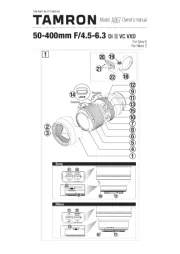
1 September 2025
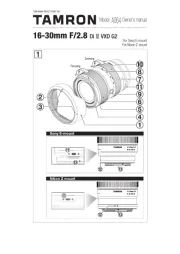
1 September 2025
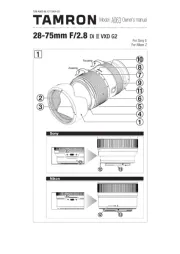
5 Augustus 2025
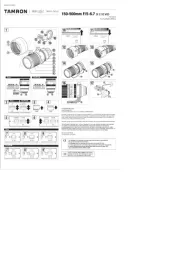
10 Juni 2025

2 April 2025

25 November 2024

16 November 2024

16 November 2024

16 November 2024

16 November 2024
Handleiding Lens
- Bresser
- Sensei
- Freelensing
- Viltrox
- Flir
- Hanwha
- Zeiss
- Gaggenau
- 7artisans
- Sony
- COLBOR
- Accsoon
- Fujifilm
- NiSi
- Pentax
Nieuwste handleidingen voor Lens
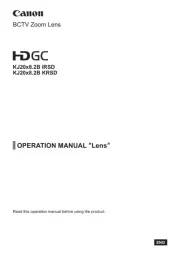
1 September 2025

31 Augustus 2025
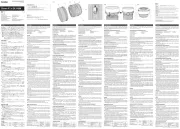
31 Augustus 2025
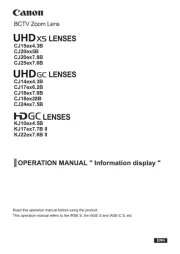
27 Augustus 2025
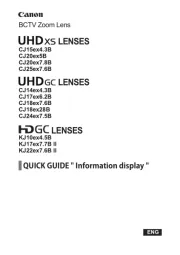
26 Augustus 2025
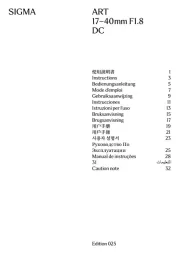
25 Augustus 2025

18 Augustus 2025
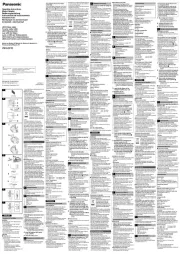
18 Augustus 2025
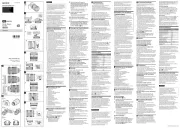
6 Augustus 2025
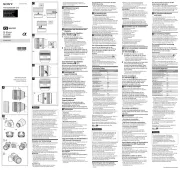
6 Augustus 2025